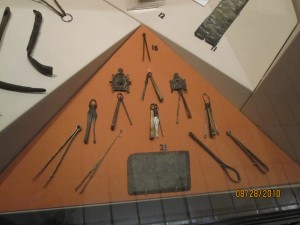The Brits pour money into their precious museums, further proof to my idea that the Brits hold their rich and storied history above all things in this fine country. The Museum of London is probably the best example; a simply laid out but large museum with easy access to the public and several treasured pieces of London history contained within its walls. Like the Museum of London, most museums are easily accessible and a majority of them are free to the public, however it seems like the museums they offer are catered to a good balance of Brits and tourists alike. While walking through a museum like the British Museum or the National Portrait Gallery, it is common to hear a slew of accents from every corner of the room. Italian, spanish, english, you name it, these people are in the museums. Of course this kind of museum experience can only come from the British government pouring tons of money into these places, making them into a piece of history themselves.
The history on display in the museums isn’t only that of the Brits, however. I am sure it took millions upon millions of dollars to acquire the historical objects contained in museums like the British museum. Perhaps this is a testament to not only the Brits appreciation of their own history, but also of the history of the world. London is without a doubt, one of the most international cities in the world. Tourists come from all over to see the sights and people from all corners of the globes live tucked away in various corners of London. All these points lead me to believe that Londoners also take great pride in acknowledging how they themselves are linked to international history and will pay big bucks for precious artifacts to be moved to their museums.
The museums themselves seem to operate like any other public establishment in the city of London. The feeling of being pushed around from queue to queue is ever present, even in a place like a museum. The result is that you kind of have to rush yourself from museums, or as a fellow classmate said in their blog recently you have to learn to “skim” museums. It took me ten minutes just to get a good view of the Rosetta Stone because of all the people crowding around, and everyone seems to have you on a two minute timer to have your look and then move on. Even in a place like the National Portrait Gallery, I got the feeling that if I spent too much time looking at a painting or sitting on a couch (the green leather was incredible) I was going to be the recipient of dirty looks from every direction. Despite being invisibly queued up in most sections of museums, there is usually enough to experience for you to get lost for days.
Overall, the museums are definitely a great aspect of London and I believe that the fact that they are subsidized is a very good thing. It keeps tourists coming and it keeps the English aware and proud of their history and their knowledge of others’. The museums of London helped me to appreciate (like a good Londoner) the value of a trip down history lane.

